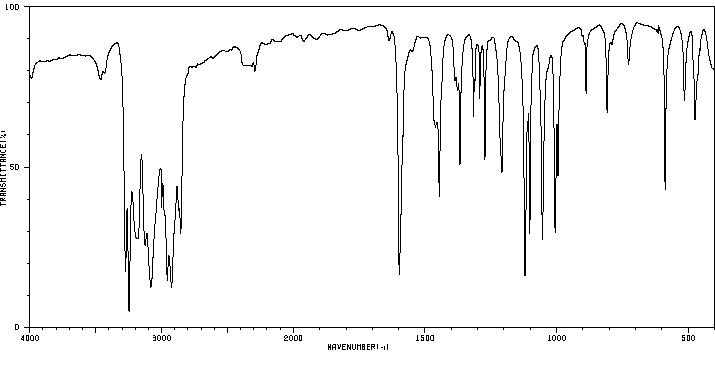Co(en)2Cl2 | 115406-60-5
中文名称
——
中文别名
——
英文名称
Co(en)2Cl2
英文别名
CoCl2(ethylenediamine)2;dichlorocobalt;ethane-1,2-diamine
CAS
115406-60-5;21199-58-6;18601-07-5
化学式
C4H16Cl2CoN4
mdl
——
分子量
250.097
InChiKey
FTWVZFRJDCDAAP-UHFFFAOYSA-L
BEILSTEIN
——
EINECS
——
-
物化性质
-
计算性质
-
ADMET
-
安全信息
-
SDS
-
制备方法与用途
-
上下游信息
-
文献信息
-
表征谱图
-
同类化合物
-
相关功能分类
-
相关结构分类
计算性质
-
辛醇/水分配系数(LogP):-0.82
-
重原子数:11
-
可旋转键数:2
-
环数:0.0
-
sp3杂化的碳原子比例:1.0
-
拓扑面积:104
-
氢给体数:4
-
氢受体数:4
反应信息
-
作为反应物:描述:参考文献:名称:纳米级二价过渡金属离子提示的大环配合物:合成,表征,分子建模和生物学研究摘要:在目前的研究工作中,钴(II),镍(II),铜(II)和锌(II)的四种新的14元四氮杂大环配合物与(1E,14E)-8,8,17,17-四甲基-使用模板方法合成了2,5,11,14-四氮杂三环[13.3.1.16,10] icosa-1,5,10,14-四烯,导致形成[MLX 2 ]类型的复合物,其中L是从乙二胺(ED)和5,5- dimethylcyclohexanedione(DCH)和X =氯衍生的大环配位- / CH 3 COO -。在红外,核磁共振,电子自旋共振,紫外可见,粉末X射线衍射,电子喷雾电离质谱(ESI-MS),热重分析,磁化率和碳氢氮分析。有关单体和非电解行为的信息已从ESI-MS和摩尔电导值中阐明。粉末X射线衍射图研究指向配合物的结晶或无定形性质。所有化合物均表现出非电解性质。使用Gaussian 09软件执行半经验计算,并确定量子化学参数。通过琼脂孔扩散法检查了DOI:10.1002/jccs.201900139
-
作为产物:描述:参考文献:名称:纳米级二价过渡金属离子提示的大环配合物:合成,表征,分子建模和生物学研究摘要:在目前的研究工作中,钴(II),镍(II),铜(II)和锌(II)的四种新的14元四氮杂大环配合物与(1E,14E)-8,8,17,17-四甲基-使用模板方法合成了2,5,11,14-四氮杂三环[13.3.1.16,10] icosa-1,5,10,14-四烯,导致形成[MLX 2 ]类型的复合物,其中L是从乙二胺(ED)和5,5- dimethylcyclohexanedione(DCH)和X =氯衍生的大环配位- / CH 3 COO -。在红外,核磁共振,电子自旋共振,紫外可见,粉末X射线衍射,电子喷雾电离质谱(ESI-MS),热重分析,磁化率和碳氢氮分析。有关单体和非电解行为的信息已从ESI-MS和摩尔电导值中阐明。粉末X射线衍射图研究指向配合物的结晶或无定形性质。所有化合物均表现出非电解性质。使用Gaussian 09软件执行半经验计算,并确定量子化学参数。通过琼脂孔扩散法检查了DOI:10.1002/jccs.201900139
文献信息
-
Complexation in a 5-acylpyrimidine-4-thione—aliphatic diamine—metal(II) chloride system (M = Ni or Co). The molecular structure of fac-tris(5-acetyl-2,4-dimethylpyrimidine-6-thiolato)cobalt(III)作者:E. K. Beloglazkina、A. A. Chizhevskii、V. N. Nuriev、R. L. Antipin、N. V. Zyk、I. V. Chernyshev、A. A. Moiseeva、K. P. ButinDOI:10.1007/s11172-006-0189-z日期:2005.12bridge between the nitrogen atoms in the diamine molecule, (3) the nature of complex-forming metal, and (4) the pyrimidinethione: diamine ratio. The resulting complexes were studied by electrochemical methods. The mechanism of electrooxidation and electro-reduction of 5-acylpyrimidine-2-thiones and related nickel and cobalt complexes was proposed. The structures of the complexes were investigated by NMR研究了在 NiII 和 CoII 盐存在下 5-acylpyrimidine-4-thiones 与脂肪族二胺的反应。合成了带有嘧啶硫酮系列配体的新型 NiII 和 CoIII 配合物。5-乙酰-6-甲基-2-苯基嘧啶-4-硫酮和5-乙酰-2,6-二甲基嘧啶-4-硫酮与乙二胺或1,3-二氨基丙烷在NiCl2·6H2O存在下的反应结果或 CoCl2·6H2O 取决于(1)嘧啶环第 2 位取代基的性质,(2)二胺分子中氮原子间多亚甲基桥的长度,(3)络合物形成金属的性质, (4) 嘧啶硫酮:二胺比例。通过电化学方法研究所得配合物。提出了5-酰基嘧啶-2-硫酮及相关镍钴配合物的电氧化和电还原机理。通过核磁共振、紫外-可见光谱、红外光谱和质谱研究了配合物的结构。通过 X 射线衍射确定 fac-tris(5-acetyl-2,4-dimethylpyrimidine-6-thiolato)cobalt
-
A study of the non-electrostatic interaction micelle/charged ligand: A comparison of the results obtained by two different methods作者:R. Jiménez、E. García-Fernández、E. Grueso、I. Fernández、I. Marín、J.J. Sanz、L.A. Torrado、D. Villegas、L. González、H.K. Stürekow、M. Leon、F. Lería、E.M. Machuca、L.M. Martinez、J. Morales、I. Villa-Bernaldez、R. Prado-GotorDOI:10.1016/j.cplett.2005.10.074日期:2006.1A kinetic study of the reaction between [Fe(CN)6]4− (hexacyanoferrate (II)) and [Co(en)2Cl2]+ (trans-dichlorobis cobalt(III) bis(ethylenediammine)) has been carried out in sodium dodecyl sulphate (SDS) micellar solutions containing NaCl. The results are discussed by using an approach based on the pseudophase model. Trends in the observed reactivity are explained by a change in the degree of association
-
Skopenko, V. V.; Bolelyi, V. F.; Keler, Kh., Ukrainskij Khimicheskij Zhurnal, 1982, vol. 48/4, p. 5 - 8作者:Skopenko, V. V.、Bolelyi, V. F.、Keler, Kh.DOI:——日期:——
表征谱图
-
氢谱1HNMR
-
质谱MS
-
碳谱13CNMR
-
红外IR
-
拉曼Raman
-
峰位数据
-
峰位匹配
-
表征信息
同类化合物
黄原酸环癸酯
高纯三甲基锑
顺式-二氯二(环丙胺)铂(II)
顺式-二氯二(乙二胺)氯化铑(1+)
顺式-二(环己基丁氨合)二氯铂(II)
顺式-二(异丙基氨合)二氯铂(II)
顺式-(2-氨基甲基-1-环戊基氨合)二氯铂(II)
顺二氯二羰基铂(II)
顺-二氯双(乙二胺)氯化铱
雷(酸)汞[含水或水加乙醇≥20]
间碳硼烷-9-硫醇
镍,加合(7:2)钪
镉二(二戊基二硫代氨基甲酸盐)
镁,溴-6-庚烯基-
manganese carbide
butyl manganese bromide
锡烷,氯二环己基-
锡四丁醇
锑,(1:1)混合物和钪
锌叔-丁氧化物
锌,溴-1-丙烯基-,(E)-
锇,加合(2:1)钪
锆酸四丁酯
锂丁酯
锂4-异丙氧基-2-甲基-丁烷-2-醇
锂1-丁醇
锂(三氟甲基)乙炔化物
锂(3-氨基丙基)酰胺
铼五羰基碘化物
铼五羰基
银(I)2-羟基乙烷-1-硫醇盐
铯三氯三羰基锇
铬三乙二胺
铬,五羰基(环己胺)-,(OC-6-22)-
铬,二(乙酰腈)二氯-
铝,加合(3:1)钪
铜-乙二胺络合物
铜(II)乙二胺
铜(I)乙炔化物
铍,环戊-1,3-二烯,溴化
铊N,N-二正丁胺
铊,甲氧基二甲基-
铂(2+)二氯化3-甲基丁烷-1,2-二胺(1:1)
铁(3+)三(1-丁醇)
铁(2+)1,1'-(硫烷二基二-1,1-乙二基)二-2,4-环戊二烯化
铀,三甲基-
钾,[三(三甲基甲硅烷基)甲基]-
钴四异硫氰酸酯
钴,乙烷-1,2-二胺
钠辛基二硫代氨基甲酸酯







